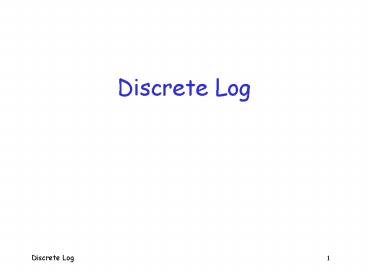Discrete Log - PowerPoint PPT Presentation
Title:
Discrete Log
Description:
Discrete Logarithm Discrete log problem: Given p, g and ga (mod p), determine a This would break Diffie-Hellman and ElGamal Discrete log algorithms analogous to ... – PowerPoint PPT presentation
Number of Views:57
Avg rating:3.0/5.0
Title: Discrete Log
1
Discrete Log
2
Discrete Logarithm
- Discrete log problem
- Given p, g and ga (mod p), determine a
- This would break Diffie-Hellman and ElGamal
- Discrete log algorithms analogous to factoring,
except no sieving - This makes discrete log harder to solve
- Implies smaller numbers can be used for
equivalent security, compared to factoring
3
Discrete Log Algorithms
- We discuss three methods
- Trial multiplication
- Analogous to trial division for factoring
- Baby-step giant-step
- TMTO for trial multiplication
- Index calculus
- Analogous to Dixons algorithm
4
Trial Multiplication
- The most obvious thing to do
- We know p, g and ga (mod p)
- To find a, compute
- g2 (mod p), g3 (mod p), g4 (mod p),
- Until one matches ga (mod p)
- Expected work is about p/2
5
Baby Step Giant Step
- Speed up to trial multiplication
- Again, know p, g and x ga (mod p)
- We want to find exponent a
- First, let m ?sqrt(p ? 1)?
- Then a im j, some i,j ? 0,1,,m?1
- How does this help? Next slide
6
Baby Step Giant Step
- Have x ga (mod p) gimj (mod p)
- Therefore, gj xg?im (mod p)
- If we find i and j so that this holds, then we
have found exponent a - Since a im j
- How to find such i and j ?
7
Baby Step Giant Step
- Algorithm Given x ga (mod p)
- Giant steps Compute and store in a table,
- xg?im (mod p) for i 0,1,m?1
- Baby steps Compute gj (mod p) for j 0,1,
until a match with table obtain a im j - Expected work sqrt(p) to compute table,
sqrt(p)/2 to find j, for total of 1.5 sqrt(p) - Storage sqrt(p) required
8
Baby Step Giant Step Example
- Spse g 3, p 101 and x ga (mod p) 37
- Then let m 10 and compute giant steps
- Next, compute 3j (mod 101) until match found with
last row - In this case, find 34 37 ? 3?20 (mod 101)
- And we have found a 24
9
Index Calculus
- Given p, g, x ga (mod p), determine a
- Analogous to Dixons algorithm
- Except linear algebra phase comes first
- Choose bound B and factor base
- Suppose p0,p1,,pn?1 are primes in factor base
- Precompute discrete logs logg pi for each i
- Can be done efficiently
- Corresponds to linear algebra phase in Dixons
10
Index Calculus
- Next, randomly select k ? 0,1,2,,p?2 and
compute y x ? gk (mod p) until find y that
factors completely over factor base - Then
- Take logg and simplify to obtain
- a logg x (d0logg p0 d0logg p0
- d0logg p0 ? k) (mod (p ? 1))
- And we have determined a
- Note p ? 1 follows from Fermats Little Thm
11
Index Calculus Example
- Spse g 3, p 101, x 3a 94 (mod p)
- We choose factor base 2,3,5,7
- Compute discrete logs log32 29, log33 1,
log35 96, log37 61 - Select random k, compute y x ? gk (mod p) until
y factors over factor base - For k 10, find y 50 2 ? 52 mod (101)
12
Index Calculus Example
- For k 10, have y 50 2 ? 52 mod (101)
- Then
- a (log3 2 2 log3 5 ? 10) (mod 100)
- 29 2 ? 96 ? 10 11 (mod 100)
- Easy to verify 311 94 (mod 101)
- Work is same as Dixons algorithm
- In particular, work is subexponential
13
Conclusions
- Many parallels between factoring and discrete log
algorithms - For example, Dixons and index calculus
- For discrete log, not able to sieve
- Therefore, no analog of quadratic sieve
- For elliptic curve cryptosystems (ECC)
- No analog of Dixons or index calculus
- since no concept of a factor base
- So ECC is secure with smaller parameters

